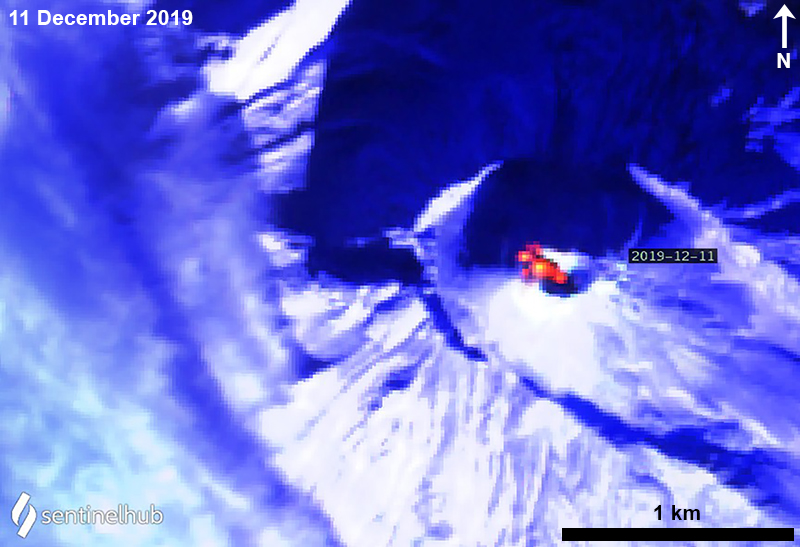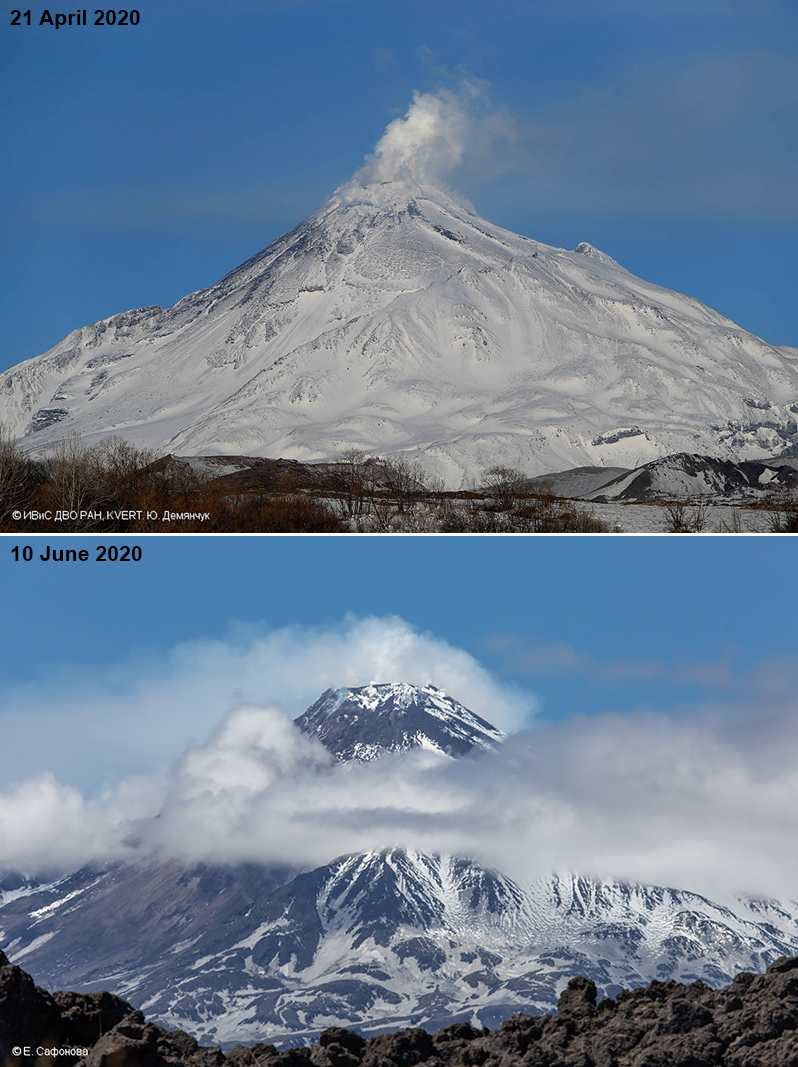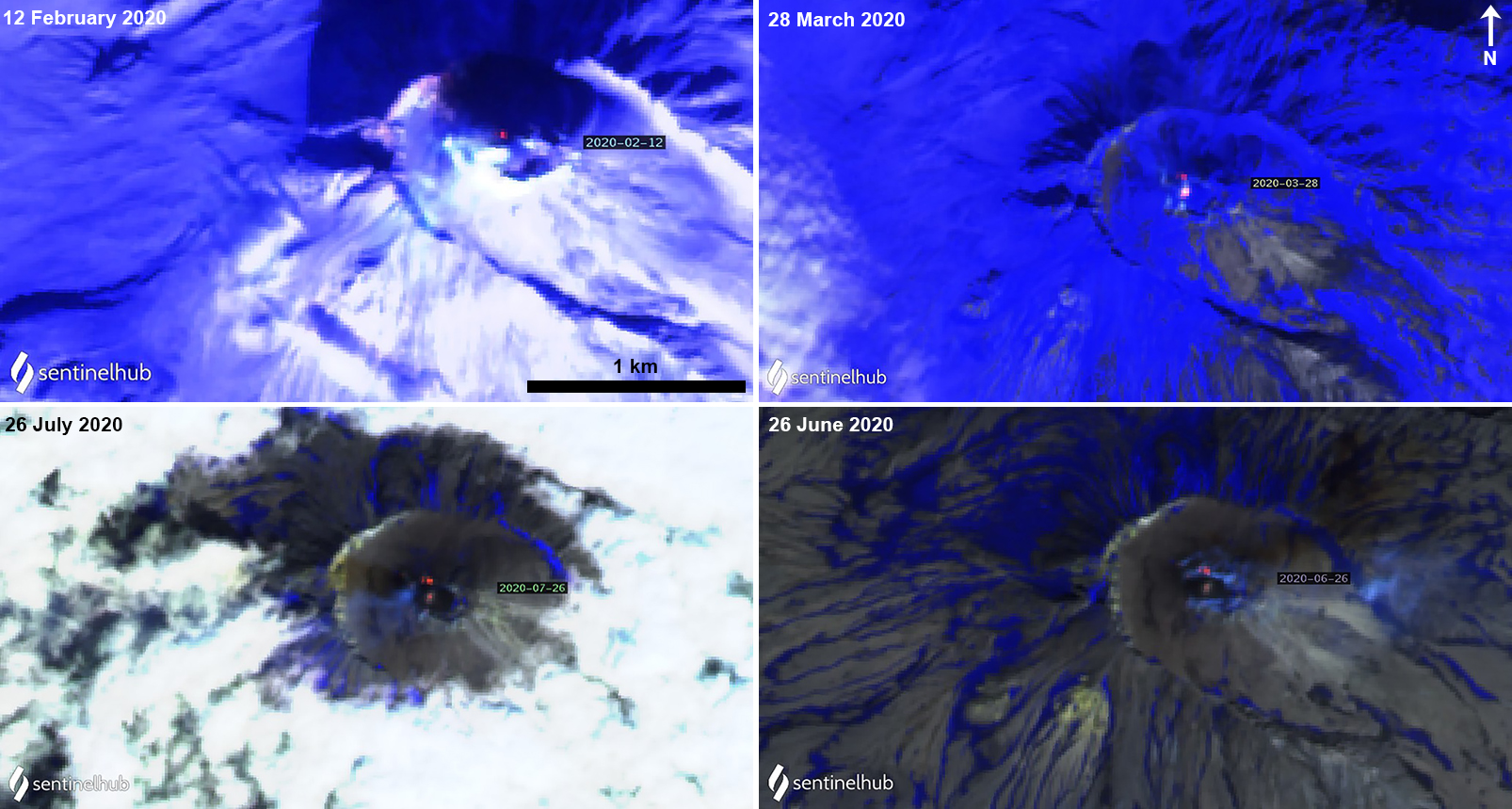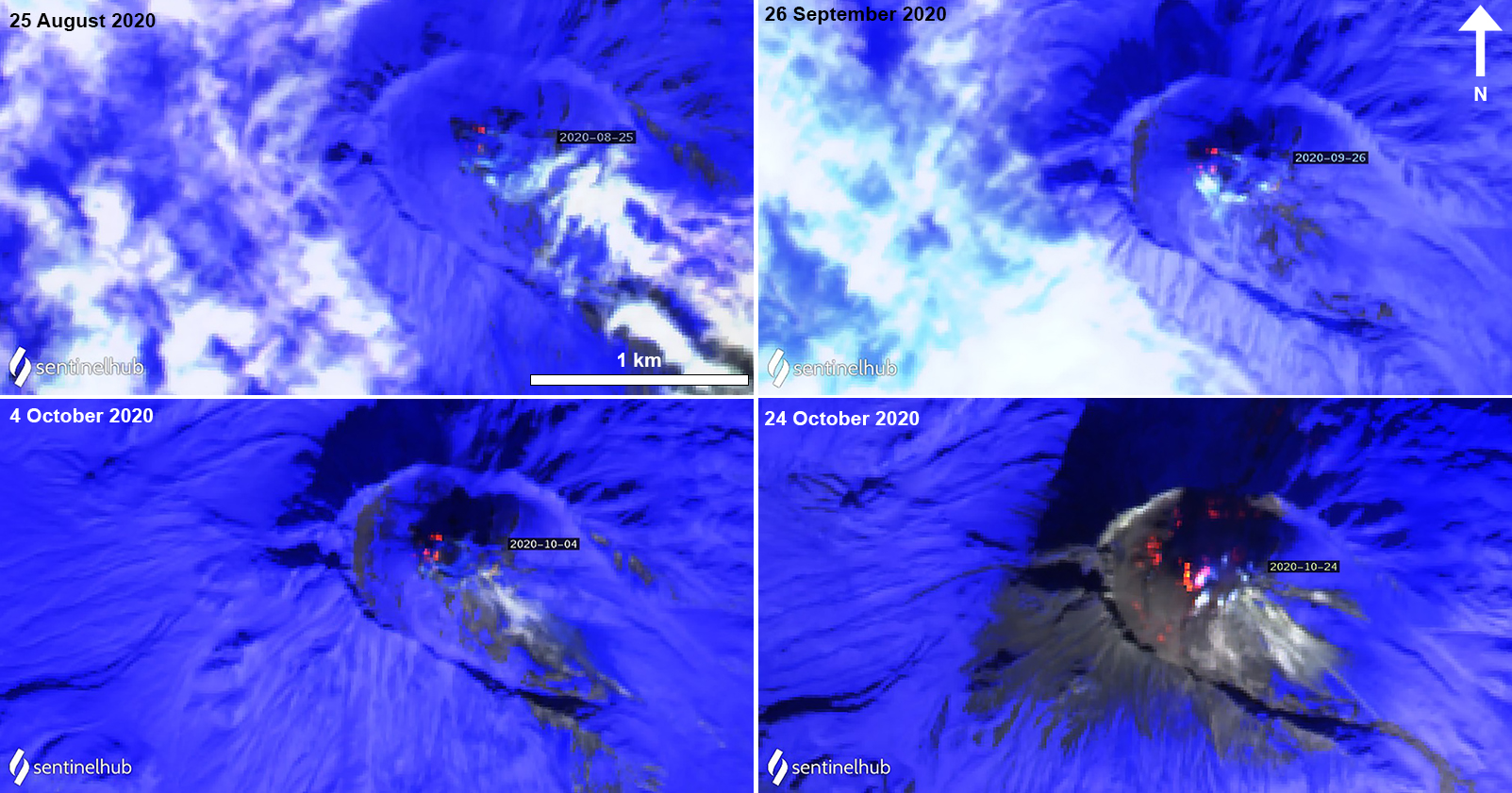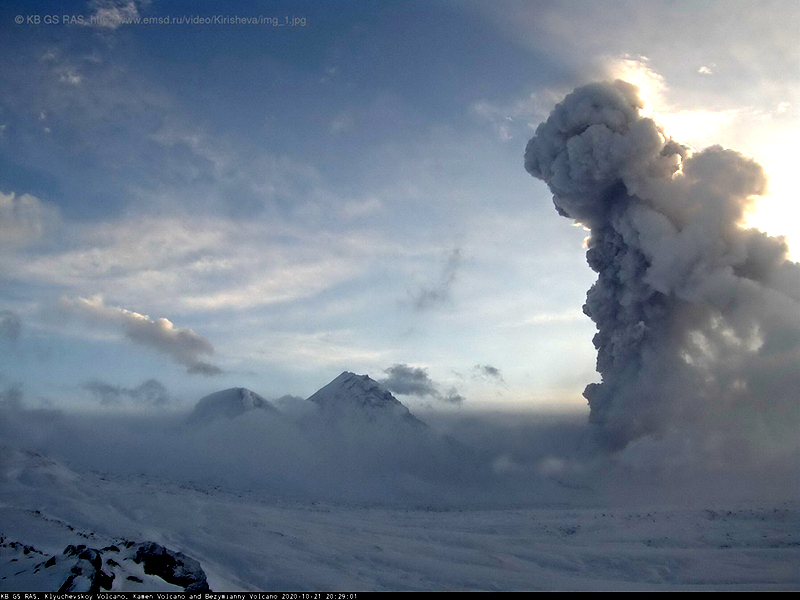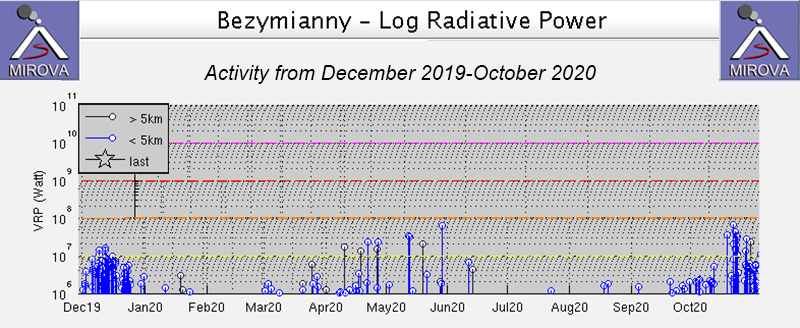Report on Bezymianny (Russia) — November 2020
Bulletin of the Global Volcanism Network, vol. 45, no. 11 (November 2020)
Managing Editor: Edward Venzke.
Edited by Kadie L. Bennis.
Bezymianny (Russia) Lava dome growth and thermal anomalies during December 2019-October 2020; ash explosion on 22 October
Please cite this report as:
Global Volcanism Program, 2020. Report on Bezymianny (Russia) (Bennis, K.L., and Venzke, E., eds.). Bulletin of the Global Volcanism Network, 45:11. Smithsonian Institution. https://doi.org/10.5479/si.GVP.BGVN202011-300250
Bezymianny
Russia
55.972°N, 160.595°E; summit elev. 2882 m
All times are local (unless otherwise noted)
Bezymianny has had frequent eruptions dating back to 1955, which has more recently consisted of ongoing low-level thermal anomalies, gas-and-steam emissions, lava dome growth, and occasional ash explosions (BGVN 44:06 and 44:12). Volcanism during December 2019 to October 2020 was characterized by primarily nighttime crater incandescence and strong fumarolic emissions, as well as a lava flow during December 2019 and an ash explosion during October 2020. Information comes from the Kamchatka Volcano Eruptions Response Team (KVERT), the Tokyo Volcanic Ash Advisory Center (VAAC), and satellite data.
Volcanism during December 2019 consisted of strong fumarolic activity, accompanied by a persistent thermal anomaly above the lava dome. On 7 October a gas-and-steam plume containing some amount of ash rose 5.5 km altitude and drifted SE according to the Kamchatka Branch of the Geophysical Service. Starting on 11 December nighttime crater incandescence was observed due to the presence of a lava flow (figure 34); the temperature of the thermal anomaly gradually began to increase. On 20 December a small lava flow was observed on the W flank of the lava dome, accompanied by a strong fumarole.
After the thermal activity occurred in December, volcanism significantly decreased through the end of the year, which included the temperature of the thermal anomaly; nighttime lava dome incandescence was no longer visible. Moderate gas-and-steam emissions continued frequently during the first seven months of 2020, in addition to a weaker, yet consistent, thermal anomaly over the lava dome, as seen in Sentinel-2 satellite images (figures 35 and 36).
On 26 August a new lava dome was observed growing in the summit crater, according to KVERT (figure 37). Lava dome growth continued through October, coincident with an increase in the strength and size of the thermal anomaly seen in Sentinel-2 thermal satellite imagery (figure 38). Low-level activity consisting of strong fumaroles persisted through September. Activity in early October was characterized by continued moderate gas-and-steam activity and a visible thermal anomaly over the lava dome.
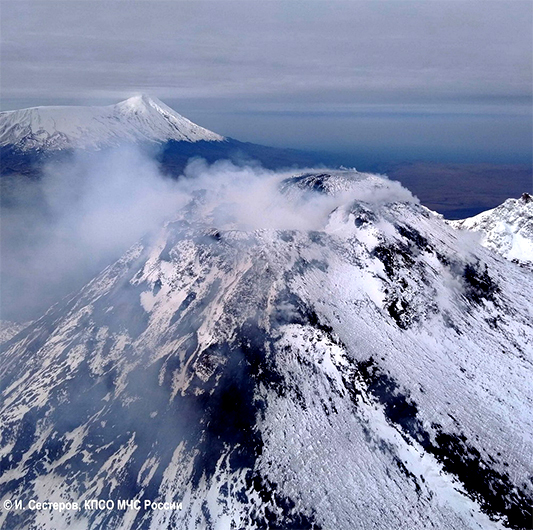 |
Figure 37. Photo of the new lava dome growing in the summit crater of Bezymianny on 26 August 2020. Photo by I. Sesterov, KSRS ME; courtesy of IVS FEB RAS, KVERT. |
On 22 October at 0822 (local time) explosive eruptions produced a large ash plume that rose 9 km altitude and measured 100 x 200 km in size (figure 39). The eruption was over by 1519, though the ash plume continued to be visible up to 5-5.5 km altitude, splitting into a N (57 x 105 km) and S (36 x 67 km) part and drifting more than 800 km NW and SE. By 24 October the ash clouds had dispersed. The lava dome continued to grow through the end of the month, accompanied by strong fumarolic activity. During 22-24 and 27-29 October the N part of the lava dome was activity and possibly advanced. On 30 October an active lava flow was observed on the N flank of the lava dome, accompanied by a strong thermal anomaly, which could also be seen in thermal satellite imagery.
The MIROVA (Middle InfraRed Observation of Volcanic Activity) volcano hotspot detection system based on analysis of MODIS data showed a pulse in thermal activity during December 2019 due to the presence of a lava flow on the W flank of the lava dome (figure 40). A second pulse of intermittent activity was detected during February through early June 2020, which was also seen occasionally in Sentinel-2 thermal satellite imagery (figure 36). Finally, a third pulse of more frequent and strong thermal anomalies occurred from late August through October, which were also clearly visible in thermal satellite imagery (figure 38). According to the MODVOLC thermal algorithm, two thermal hotspots were detected on 12 December 2019 and 23 October 2020, both of which marked the presence of the lava flow on the W flank of the lava dome and the ash explosion, respectively.
Geological Summary. The modern Bezymianny, much smaller than its massive neighbors Kamen and Kliuchevskoi on the Kamchatka Peninsula, was formed about 4,700 years ago over a late-Pleistocene lava-dome complex and an edifice built about 11,000-7,000 years ago. Three periods of intensified activity have occurred during the past 3,000 years. The latest period, which was preceded by a 1,000-year quiescence, began with the dramatic 1955-56 eruption. This eruption, similar to that of St. Helens in 1980, produced a large open crater that was formed by collapse of the summit and an associated lateral blast. Subsequent episodic but ongoing lava-dome growth, accompanied by intermittent explosive activity and pyroclastic flows, has largely filled the 1956 crater.
Information Contacts: Kamchatka Volcanic Eruptions Response Team (KVERT), Far Eastern Branch, Russian Academy of Sciences, 9 Piip Blvd., Petropavlovsk-Kamchatsky, 683006, Russia (URL: http://www.kscnet.ru/ivs/kvert/); Kamchatka Branch of the Geophysical Service, Russian Academy of Sciences (KB GS RAS) (URL: http://www.emsd.ru/); Tokyo Volcanic Ash Advisory Center (VAAC), 1-3-4 Otemachi, Chiyoda-ku, Tokyo 100-8122, Japan (URL: http://ds.data.jma.go.jp/svd/vaac/data/); MIROVA (Middle InfraRed Observation of Volcanic Activity), a collaborative project between the Universities of Turin and Florence (Italy) supported by the Centre for Volcanic Risk of the Italian Civil Protection Department (URL: http://www.mirovaweb.it/); Hawai'i Institute of Geophysics and Planetology (HIGP) - MODVOLC Thermal Alerts System, School of Ocean and Earth Science and Technology (SOEST), Univ. of Hawai'i, 2525 Correa Road, Honolulu, HI 96822, USA (URL: http://modis.higp.hawaii.edu/); Sentinel Hub Playground (URL: https://www.sentinel-hub.com/explore/sentinel-playground).


